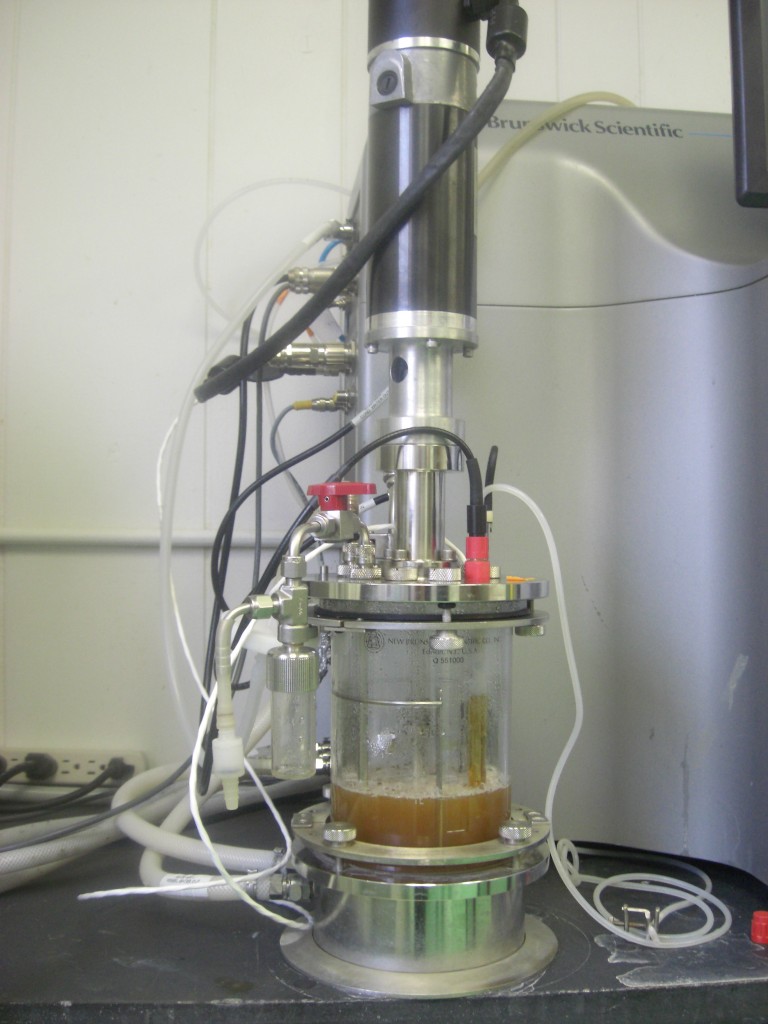The chance to see biochemicals go to market has humans working as hard as the microorganisms that produce them
A white brick building in East Lansing, Mich. hides among residential homes and the shadow of an apartment complex’s white towers. The small, simple sign out front reads: Working Bugs.

Working Bugs is an East Lansing based company that uses microorganisms to create biochemicals. Photo: Kimberly Hirai
Inside, the building smells of rubbing alcohol and bacterial cultures. That’s because the bugs at Working Bugs are microorganisms like bacteria and fungi. They produce chemicals to replace petroleum in plastics, clothing, fuel and other products.
Most residents don’t know that owner and manager Dianne Holman runs a biorefinery in their backyard, but she’s one of several entrepreneurs in this mid-Michigan town’s growing biomanufacturing industry.
Biomanufacturing uses biological chemicals or materials in place of petroleum to make products. Bikes made from waste wood products or KTM Industries’ children’s craft peanuts, made from cornstarch, are a few examples, said Tracey Maroney, executive director of Greater Mid-Michigan Bio-Manufacturing Alliance.
East Lansing’s grassroots biomanufacturing movement is five years old and has 25 to 30 companies, Maroney said. The industry includes universities, industrial giants like Ford Motor Co. and Dow Chemical and startups like Working Bugs.
“Michigan is a traditional manufacturing state,” Maroney said. “I think it’s the young, innovative entrepreneur-ish mindset that’s really going to drive this biosector.”
Biorefineries are just one part of the industry. Holman and her team identify microorganisms that produce chemicals during fermentation. The company once focused on N-butanol, an ingredient used in cosmetics like nail polish. Holman’s group worked to make a bio-based equivalent. Maroney said young companies can move quickly.

Dianne Holman went from civil engineer to biomanufacturing entrepreneur in 2006. Photo: Kimberly Hirai.
Working Bugs will release new products late this summer. Holman won’t say what they are. Just like her quiet operation, Holman is like the company safe. Patents are pending, so she keeps her mouth shut.
Holman isn’t a typical entrepreneur. Instead of a power suit, she wears black jeans, a comfortable algae-green sweater and a yellow t-shirt. She went from civil engineer to biomanufacturing entrepreneur after a 14-year career with the Michigan Department of Environmental Quality.
She formed Working Bugs in 2006, hoping to see Michigan regain its manufacturing might and contribute to it.
After years of looking at other people’s projects, she itched to create her own.
“I think I always envied to be on the design side of things,” Holman said.
In the fermentation lab, glass vessels with metal stir sticks mix broth the color of beer.

Working Bugs uses a bioreactor to find the right mix of conditions and ingredients microorganisms need to grow. Fermentation creates the biochemicals staff use to replace petroleum in products. Photo: Kimberly Hirai
Sugar stock, nutrients, water and microorganisms make up a recipe that is constantly tweaked–Holman says bugs can be fussy, and her team discovers the temperature, pH, food and other lifestyle conditions they prefer.
The company first processed local potatoes for a sugar feedstock to nourish their hungry microorganisms. Now they use premade stocks from Michigan sugar beets, among other sources for ease, but Holman hopes to again make sugar feedstocks from local food sources in the future.
Graduating through a series of larger and larger vessels, microorganisms multiply in number. Thousands or millions of microorganisms eventually undergo fermentation at the manufacturing scale. As they use up the sugar feedstock, they begin to drown in the chemical product produced.
“It’s like dying in your own pee,” Holman said.
The biochemical is separated from the microorganism through a series of extractions and purification steps, all of which Holman keeps secret.
Working Bugs has figured out how to use the waste from the reaction for other products. It’s sort of like extreme recycling.
“We try to use everything,” Holman said. “Our goal is to have no waste streams.”
There is much to accomplish on the cutting edge of a new industry.
“This is a sector where you have to create your own market,” Holman said. “You’re competing with well-established, traditional processes.”
But traditional chemical and petroleum companies have shown renewed interest in biomanufacturing, according to David Jones, chief business officer for the Michigan Biotechnology Institute, MBI International.
“During the downturn they downsized a lot of their research capability and scale-up capability so now they’re looking to partner with universities and places like MBI to do that,” he said.
The institute takes biomanufacturing ideas and commercializes them. The industry is still young.
“This is still an emerging market and everybody is really trying to carve out a niche in technology just to try and get the industry started,” he said.
Holman plans to produce her own products, but Maroney said part of building the chain of entrepreneurs, suppliers, researchers and manufacturers is networking.
“I’ve got to work really hard to connect [them] together because we don’t want those ideas to stay locked up in an ivory tower,” Maroney said.
As the industry expands, so does Working Bugs.
Like its microorganisms, the company outgrew its vessel–it will manufacture chemicals in greater quantities by moving to a larger facility in the coming months. Holman said she looks forward to seeing more companies like her own.
Replacing current manufacturing methods with new ideas can help, she said.
“Sometimes it takes bad things happening to the traditional method to get people to focus on maybe we need to do things a new way,” she said.
Pingback: Michigan bio-industry seeks federal, state boost | Great Lakes Echo